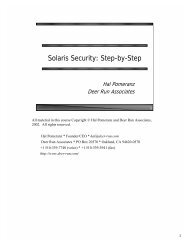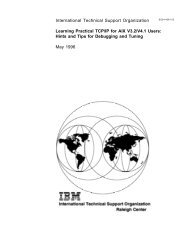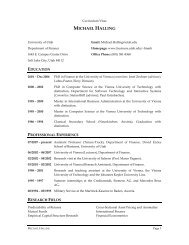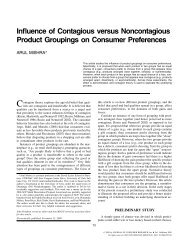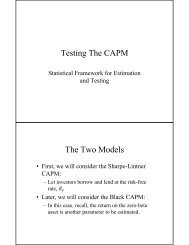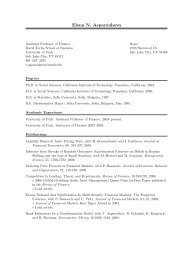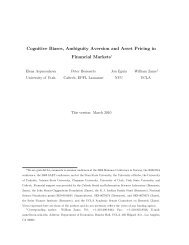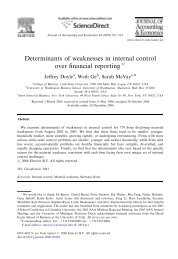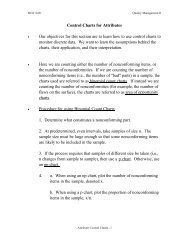Annual Report - David Eccles School of Business - University of Utah
Annual Report - David Eccles School of Business - University of Utah
Annual Report - David Eccles School of Business - University of Utah
You also want an ePaper? Increase the reach of your titles
YUMPU automatically turns print PDFs into web optimized ePapers that Google loves.
Letter from Fund Advisor,Dr. Elizabeth TashjianThis academic year, the Student InvestmentFund entered its second decade as a class. Thelast twelve months have been a challengingtime for investors as uncertainty persists as tothe timing <strong>of</strong> the end <strong>of</strong> the recession and thespeed <strong>of</strong> the recovery. Unemployment hasremained high while interest rates remainunusually low. Major news stories included theEuropean debt crisis, swings in consumerconfidence, the Gulf oil spill, and a strong antiincumbentpolitical climate.research program. In 2013, we will move intothe Trading Room in the new business building.Congratulations to the 2009-2010 managers ona very successful year.For the fourth consecutive year, the fund hasoutperformed the S&P. Despite the tight jobmarket, SIF alumni have continued to receivehighly competitive job <strong>of</strong>fers both in <strong>Utah</strong> andaround the country. SIF members have beenleaders on campus in ASUU, Top Jobs, UVF, inthe President’s <strong>of</strong>fice, in the Bennion Center,and in the MUSS. Five SIF students (fourcurrent students and one alumna) participatedin the first CFA International ResearchChallenge in the state <strong>of</strong> <strong>Utah</strong>, narrowly losingto BYU’s MBA team, which went on to win thechallenge for the Americas.When the fund began as a club in 1998, therewere no experiential undergraduate classes inthe business school and no special programs fortop business students. The Student InvestmentFund has helped to precipitate many changes.A few years after the Fund’s inception, MikeLemmon and I launched the Finance Honorsprogram as it became clear that our strongundergraduate students sought a stronger set <strong>of</strong>classes. That program has grown to be one <strong>of</strong>the most successful honors programs oncampus, and the business school now <strong>of</strong>fershonors in all areas. We now have a wide array<strong>of</strong> experiential classes. SIF alumni continue toget excellent jobs. Many have gone on tograduate programs in business, law, andmedicine.I anticipate more exciting changes in oursecond decade. Next year, we will incorporatethe Capital IQ platform into our SIF investment7 | P age
What We Hold & What We SoldThe <strong>David</strong>son PortfolioHighlightsSince August 25, 2009, when the new fundmanagers took over the <strong>David</strong>son Portfolio, the<strong>David</strong>son portfolio has returned 20.99%compared to 16.18% and 21.23% for the S&P500 and NASDAQ indices, respectively. Duringthis time period the fund managers purchasedSales Force (CRM), Under Armour (UA), Celgene(CELG), and additional shares <strong>of</strong> Cerner (CERN);they agreed to sell Aldila (ALDA), WilliamsCompanies (WMB), Research in Motion (RIMM),and General Electric (GE).Over the 2009-2010 academic school year onlytwo stocks in the <strong>David</strong>son Portfolio decreasedin value, while ten out <strong>of</strong> thirteenoutperformed the S&P 500. The best performerin the portfolio was Williams Companies (WMB),which had a compounded eight month return <strong>of</strong>92.58%.This was largely due to the steadyincrease in the price <strong>of</strong> oil as well as theoverall improvement in the economy sinceAugust 2009.As <strong>of</strong> April 9, 2010, the <strong>David</strong>son Portfolio had avalue <strong>of</strong> $61,504.70. It is most heavily weightedin healthcare, with 35% <strong>of</strong> its holdings in thissector.StrategyThe <strong>David</strong>son portfolio is subsidized by D.A.<strong>David</strong>son, so that the fund is replenished if itsvalue drops below $50,000. When the fundexperiences gains over 5%, the fund splits thegains in half with D.A. <strong>David</strong>son. The fundstrategy for the <strong>David</strong>son Portfolio is to investin high growth stocks which are <strong>of</strong>ten small capstocks <strong>of</strong> relatively new companies that maycarry considerable risk.Individual Holdings (prices as <strong>of</strong> April 9):Celgene PharmaceuticalsTicker: CELGPurchased: Feb 24, 2010Purchase Price: $59.20Current Price: $61.89Analyst: February GroupCelgene is a bio-pharmaceutical companyfocused on developing drugs which target bloodcancers including multiple myeloma,myelodysplastic syndrome, non-Hodgkin’slymphoma, and chronic lymphocytic leukemia.Celgene also specializes in finding treatmentsfor ADHD, solid tumors, and inflammatorydiseases. Celgene was founded in 1986 andcompleted its initial public <strong>of</strong>fering in 1987. Itcurrently operates in more than 65 countriesincluding Eastern Europe, Japan, Australia,Southeast Asia, and Latin America.The fund purchased CELG to take advantage <strong>of</strong>the stock growth we anticipate should thecompany’s key drug, Revlimid, be approved forfirst line treatment <strong>of</strong> multiple myeloma. Firstline treatment status for Revlimid means thatthe company’s drug would be the first drugprescribed to newly diagnosed patients, leadingto a dramatic increase in market share. Aftercareful analysis <strong>of</strong> the drug’s quality andefficacy compared to the competition, thelikelihood <strong>of</strong> passing the FDA first linetreatment approval process is quite high.Through a discounted cash flow analysis, wehave approximated Celgene’s stock price valueat $75. Once Revlimid is approved and thestock price reflects the gain in value, werecommend that the fund should sell the stock.Cerner Corp.Ticker: CERNPurchased: Feb 10, 2006, Oct 7, 2009Purchase Price: $42.10, $75.76Inherited Price: $64.27Current Price: $88.19Analyst: Travis GiguereCerner Corporation provides healthcare ITs<strong>of</strong>tware solutions that combine clinical,financial, and management informationsystems. Cerner’s largest customers include8 | P age
hospitals, laboratories, blood banks,pharmacies, and public health organizations. Itsflagship product, the Cerner MillenniumSystem, provides access to an individual’selectronic medical records at the point <strong>of</strong> care.The system organizes and delivers informationfor healthcare pr<strong>of</strong>essionals as well asconsumers.Previous fund managers held this stock becausenet income and cash flow have increased yearover year, sales and employees have increased,and it belongs in a strong sector. All <strong>of</strong> thesepoints still hold true today, however there wasa decrease in cash flow during 2009. During2009, Cerner purchased $169 million <strong>of</strong> shortterm government bonds. If Cerner had notinvested this cash in government bonds, cashflow would have doubled from 2008. Theeconomic stimulus package has set aside $19.5billion for healthcare IT during the next tenyears. Congress is hoping the money willinfluence hospitals and doctors to start usingelectronic heath records, which is Cerner’sprimary focus. Cerner has low long-term debtto-equitylevels and high pr<strong>of</strong>it margins relativeto the industry.CyberSource CorporationTicker: CYBSPurchased: Nov 27, 2007Purchase Price: $15.81Inherited Price: $15.81Current Price: $18.52Analyst: Chris BartonCyberSource was founded in 1996 at thebeginning <strong>of</strong> the E-commerce boom, and isconsidered to be the first online paymentprocessor. CyberSource started by creatingelectronic payment and fraud detectiontechnology. Products and services <strong>of</strong>fered byCyberSource are designed to assist merchantsin managing transactions including paymentprocessing services, enterprise s<strong>of</strong>tware, andpr<strong>of</strong>essional services. Online retailers, whichlargely started with the acceptance <strong>of</strong> creditcards as a form <strong>of</strong> payment, have successfullyadapted to new forms <strong>of</strong> payment includingdebit cards, electronic checks, gift cards,PayPal, and Bill Me Later® for customersatisfaction and security purposes. As E-commerce grows and expands, more merchantsare going global with their online services. In2007, online retail transactions wereforecasted to nearly double by 2012.The current fund managers elected to hold allshares <strong>of</strong> CyberSource Corporation for theduration <strong>of</strong> the academic year and realized aholding period return <strong>of</strong> 27.10%, or a monetaryincrease <strong>of</strong> $499.20 for the <strong>David</strong>son portfolio.With its reputation and the anticipated growthin online retail transactions, the current fundmanagers anticipate the price <strong>of</strong> CyberSource’sstock to increase to $22.00.Icon PLCTicker: ICLRPurchased: Feb 3, 2005Purchase price: $8.48*Inherited price: $22.76Current price: $26.60Analyst: Kristina Rodriguez*Split adjustedIcon PLC is a contract research organizationbased in Ireland. The company is listed as anADR on the New York Stock Exchange. ICONprovides global outsourced developmentservices to pharmaceutical, biotechnology, andmedical device industries. The companyprimarily services the United States, Ireland,and Europe. ICON focuses on conductingclinical trials, and development projects fromcompound selection to Phase I and IV clinicalstudies.ICON continues to outperform the S&P 500index. Additionally, the company experienced39.60% net income growth at the end <strong>of</strong> the2008. We believe the company’s efficientoperations will result in continued steadygrowth.9 | P age
Under ArmourTicker: UAPurchased: Dec 9, 2009Purchase Price: $26.13Current Price: $32.28Analyst: Jonathan BowenThe company develops, markets and distributesperformance apparel, footwear and accessoriesfor men, women and youth worldwide. Thesignature product for Under Armour iscompression clothing made from syntheticmoisture-wicking fabrics designed to regulatebody temperature and improve performance <strong>of</strong>the user. The company has done well inestablishing the mentality among athletes thatthey will not perform as well without usingUnder Armour products. Recently, it hasentered into the running market to competedirectly with Nike and Adidas. Under Armour,Inc. was inherited by the 2009-2010 StudentInvestment Fund as part <strong>of</strong> the Milner Fund.Prior to reporting quarterly earnings in Q42009, the Student Investment Fund decided topurchase 100 additional shares for the <strong>David</strong>sonportfolio in anticipation <strong>of</strong> a rise in stock price.Despite contending against vastly largercompetitors such as Nike and Adidas,management has historically exceededprojections as the company continues to gainmarket share in both clothing and footwear.Thus, the Student Investment Fund believesthat holding Under Armour stock long-term willbe beneficial to both portfolios.Westinghouse Air Brake TechnologiesTicker: WABPurchased: Nov 8, 2006Purchase Price: $31.47Inherited Price: $36.18Current Price: $42.60Analyst: Daniel SmartThe 2009-2010 Student Investment Fundinherited WAB from the 2008-2009 class.Westinghouse provides original equipmentmanufacturing and aftermarket services for therail industry worldwide. Its business has twomain segments: freight and transit. Its freightgroup manufactures and services componentsfor new and existing freight cars andlocomotives. Its transit group manufactures andservice components for passenger transitvehicles, primarily subway cars and buses.WAB was previously held for a few key reasonsthat are still applicable in the current year.WAB continued to acquire new contracts and itsbacklog was high with projects guaranteedthrough 2016. There is currently a large pushfor new rail lines, including high speedpassenger lines in states such as California. Thisdrive towards greener transportation will alsopromote growth within this industry.This company is expected to have consistentgrowth, and was thus held to provide stabilityand diversification to the portfolio.Divested Holdings:AldilaTicker: ALDAPurchased: Apr 4, 2007Purchase Price: $15.93Inherited Price: $3.64Sell date: Oct 7, 2009Sell Price: $3.41Analyst: Paul BurninghamAldila Inc. was inherited from the previous fundmanagers. Aldila designs, manufactures, andmarkets high performance graphite golf shafts.The company sells its graphite shafts to golfclub manufactures, distributors, custom clubshops, pro shops, and repair shops. Most <strong>of</strong>Aldila’s revenue comes from selling to largegolf club manufactures such as Callaway golf,Taylormade, and Titleist.12 | P age
In recent years Aldila has seen a significantdecline in sales. For the first half <strong>of</strong> 2009,Aldila lost $675,000 and had a decrease <strong>of</strong> 21%in shafts sales compared to 2008. The decisionto sell was based on the company’s continueddrop in sales and the poor long-term outlook <strong>of</strong>the golf industry. Aldila management predictedthe industry would contract by another 15 to20% in the coming year.On January 19, 2010, Aldila Board <strong>of</strong> Directorsunanimously approved a plan to voluntarilydelist its stock from the NASDAQ. The delistingis consistent with a continued effort to reduceexpenses. Since the delisting the stock hasclimbed from $3.93 to $5.50 as <strong>of</strong> April 15,2010.General Electric CompanyTicker: GEPurchased: Nov 12, 2008Purchase Price: $17.15Inherited Price: $14.30Sell Date: Oct 21, 2009Sell Price: $15.78Analyst: Kimyen NguyenThe fund chose to sell General Electric due tothe poor performance since purchase. The keyreasons for the sale <strong>of</strong> all shares included1. Disappointing and unpredictableperformance <strong>of</strong> GE Capital, which GEfailed to spin <strong>of</strong>f or sell,2. Concerns about the recovery time <strong>of</strong>the financial sector and GE Capital, and3. Management’s proposal <strong>of</strong> a drasticchange in the company’s operationsand marketing in emerging markets.Research in MotionTicker: RIMMPurchased: Nov 14, 2007Purchase Price: $115.53Inherited Price: $75.56Sell Date: Oct 29, 2009Sell Price: $61.24Analyst: Daniel SmartRIM’s technology facilitates wireless access toinformation such as e-mail, telephone, shortmessaging service, Internet, and Intranet-basedapplications. The company is most famous forits BlackBerry wireless platform, the RIMWireless Handhelds product line, radiomodems,and other s<strong>of</strong>tware and hardwaresolutions. Research in Motion is headquarteredin Waterloo, Canada and has additional <strong>of</strong>ficesin North America, Europe and Asia Pacific. Inearly 2009, RIM completed the acquisition <strong>of</strong>Chalk Media Corp. and Certicom Corp.This year’s fund managers sold RIM due to adecline in sales and new users combined withsignificant gains with rival, Apple’s iPhone. Webelieve that RIM will continue to lose marketshare, especially as the iphone is expected todebut on numerous wireless providers duringthe summer <strong>of</strong> 2010.Williams Companies, Inc.Ticker: WMBPurchased: Nov 5, 2008, Feb 20, 2009Purchase price: $19.37, $11.09Inherited price: $17.35Sell Date: Oct 21, 2009Sale price: $20.27Analyst: Kelly BartonThe current fund managers inherited WMB fromthe previous year’s class. Williams CompaniesIncorporated is an integrated natural gascompany. It locates, produces, gathers,processes, and transports clean-burning naturalgas to heat homes and generate electric poweracross the country. Williams’ operations areconcentrated in the Pacific Northwest, RockyMountains, Gulf coast and the easternseaboard. The previous fund managerspurchased this stock to gain access to themarket potential <strong>of</strong> natural gas. Natural gas isan extremely important source <strong>of</strong> energy forreducing pollution and maintaining a clean andhealthy environment. It is also a domestically13 | P age
abundant and secure source <strong>of</strong> energy.Environmental policies had begun to shift,making natural gas a viable source <strong>of</strong> energyand energy generation.The stock was sold due to falling natural gasprices and the unusually high amounts <strong>of</strong> gasstorage. During the month <strong>of</strong> the sale, gasstorage was approximately 15% higher than theyear before, indicating to the fund managersthat natural gas prices were prone to fall evenlower. Additionally, research showed thatnatural gas consumption was down considerablyfrom the year before, which had the highestnatural gas prices in a number <strong>of</strong> years. Thisindicated to the fund managers that natural gaswas not a good market to be in at that time.14 | P age
Milner PortfolioHighlightsSince taking over the fund in August 2009, theMilner portfolio has consistently outperformedthe S&P 500.Akamai Technologies (AKAM), WilliamsCompanies (WMB), and Nu Skin Enterprises(NUS) were the top performers, with holdingperiod returns <strong>of</strong> 82.27%, 81.37%, and 66.59%,respectively. WMB was sold in October <strong>of</strong> 2009,while the managers continue to hold onto AKAMand NUS. The biggest losers were Aldila (ALDA),Research in Motion (RIMM), and MaxwellTechnologies (MXWL), with holding periodreturns <strong>of</strong> -78.47%, -47.06%, and -6.77%,respectively.StrategyAs in the <strong>David</strong>son portfolio, we share the gainsin excess <strong>of</strong> 5% on the Milner portfolio.Therefore, we pursue a similar strategy <strong>of</strong>investing in high-growth stocks in this portfolio.Individual Holdings:ABB Ltd.Ticker: ABBPurchased: Mar 24, 2009Purchase Price: $14.22Inherited Price: $19.59Current Price: $22.33Analyst: Kristina RodriguezABB Ltd. is an international company based inSwitzerland. It is listed as an ADR in the NewYork Stock Exchange. ABB is in the industrialelectrical equipment industry. The companyprovides power and automation technologies toutility and industrial customers. It providessystems for grid systems, power generation,and substations. Furthermore, the company<strong>of</strong>fers alternating current transmission systemsand high-voltage direct current systems.Additionally, it provides products and servicesfor the renewable solar and wind sectors.We inherited ABB from the 2008-2009 managersat a price <strong>of</strong> $13.94. Despite the negative netpr<strong>of</strong>it growth, we believe ABB Ltd has thepotential to recover from the economicdownturn and realize greater pr<strong>of</strong>its. Also, ABBhas yet to realize revenues from unfinishedprojects domestically and internationally.These projects come in light <strong>of</strong> the stimuluspackaged released by governments worldwideto improve infrastructure.Activision Blizzard, Inc.Ticker: ATVIPurchased: Oct 20, 2008Purchase Price: $12.41Inherited Price: $11.87Current Price: $12.48Analyst: Shandra CorbittActivision Blizzard is a leading online andconsole game developer and publisher. Thecompany was formed through a mergerbetween Activision and a subsidiary <strong>of</strong> VivendiS.A. in July 2007. Activision Blizzard isheadquartered in Santa Monica, California. Thecompany produces game s<strong>of</strong>tware that isutilized on the Xbox, Playstation, and Nintendoconsoles as well as other portable devices andpersonal computers. The merger betweenActivision and Vivendi was a strategy tocombine “trendy” games with the consistentand “dedicated” games, <strong>of</strong> each company. Thecompany strategy includes purchasing andpartnering with smaller leading developers andintellectual property right owners. PopularActivision Blizzard game titles include Call <strong>of</strong>Duty, World <strong>of</strong> Warcraft, StarCraft, GuitarHero, and various expansion packs andvariations therein.Although the stock has experienced turmoilover the holding period, the fund decided notto sell the stock. Activision Blizzard hasexperienced record breaking sales with therelease <strong>of</strong> Call <strong>of</strong> Duty 2: Modern Warfare andwe anticipate future gains in the gamingindustry, even though sales projections for the2009 holiday season were fairly low due tolimited consumer discretionary income. The15 | P age
industry would outperform the market duringdifficult and uncertain economic times goingforward. As <strong>of</strong> April 13, 2010, the company istrading at $71.59 per share, which represents a12.74% holding period return since August 25,2009.EMC Corp.Ticker: EMCPurchased: Dec. 9, 2009Purchase Price: $16.75Current Price: $18.54Analyst: Ian DonaldsonEMC Corp. provides products and services forexternal data storage and server virtualization.EMC produces systems infrastructure, storages<strong>of</strong>tware, virtualization, and provides openconsulting services. 2010 should be a good yearfor EMC with a recovering economy translatinginto increased corporate IT budgets.As the open source leader in networkedstorage, EMC appears well positioned to takeadvantage <strong>of</strong> growth in information storage.This market is being driven by the growing needfor firms to back up every bit <strong>of</strong> data such asdigital MRIs and corporate records. EMC’sinorganic growth strategy has been successfulin keeping the firm ahead <strong>of</strong> the technologicalcurve through the strategic acquisitions <strong>of</strong>small, but quickly growing IT specialty firmssuch as VMware and Data Domain. VMware isused by all Fortune 100 companies and has 84%<strong>of</strong> the total market for virtualization servicesand s<strong>of</strong>tware.EMC has a strong brand and position in thestorage devices market and is well positionedto take advantage <strong>of</strong> the shift to cloudcomputing with its ownership <strong>of</strong> VMware. EMC’sshares appear to be headed back towards thepre-recession price <strong>of</strong> $25. We believe themarket has not fully capitalized on EMC’sfuture opportunities, and project the EMCshare price to be fairly valued at $22. Wewould recommend selling the stock if it hitsthis target within the next year.Hess CorporationTicker: HESPurchased: Jan 23, 2009Purchase price: $52.28Inherited price: $51.48Current Price: $64.75Analyst: Brad ShumpertHess Corporation engages in the exploration,development, production, purchase,transportation, and sale <strong>of</strong> crude oil andnatural gas worldwide. It operates in twosegments: exploration and production, andmarketing and refining. The exploration andproduction segment explores for, develops,produces, purchases, transports, and sellscrude oil and natural gas. Its exploration andproduction activities take place principally inAlgeria, Australia, Azerbaijan, Brazil, Denmark,Egypt, Equatorial Guinea, Ghana, Indonesia,Libya, Malaysia, Norway, Peru, Russia,Thailand, the United Kingdom, and the UnitedStates. The marketing and refining segmentmanufactures, purchases, transports, trades,and markets refined petroleum products,natural gas, and electricity. As <strong>of</strong> December 31,2009, the company operated 1,357 HESSgasoline stations. The company was founded in1920 and is based in New York, New York.The key to earnings growth for Hess issuccessful exploration for and production <strong>of</strong>crude oil, liquefied natural gas, and natural gasand their respective market prices. Overallproduction increased about 7% in 2009 and103% <strong>of</strong> production was replaced by additionsto reserves. Natural gas prices have beenstagnant but crude oil prices have more thandoubled since January 2009. Revenues declinedmore than 25% in 2009, from $ 41 million in2008 to about $30 million, due to the steep falland slow recovery <strong>of</strong> oil and natural gas prices.However, since the shares were purchased forthe Milner fund in January 2009 quarterlyrevenue has grown at a compound annualgrowth rate near 8%. Hess increased its cashreserves by 50% in 2009 with the issue <strong>of</strong> newdebt, though its debt to total capital ratioremained stable at close to 25%. Hess holds17 | P age
core acreage in the Bakken shale fields <strong>of</strong>North Dakota and saw stronger than expectedperformance from its Shenzi field in thedeepwater Gulf <strong>of</strong> Mexico in 2009. TheCompany expects production from its Bakkenfield to provide growth <strong>of</strong> about 17% <strong>of</strong> currentoverall production levels over the next fiveyears. The Company’s success is highlydependent on oil prices, and it is a strongrecovery play for 2010.Icon PLCTicker: ICLRPurchased: Feb 3, 2005Purchase price: $8.48*Inherited price: $22.76Current price: $26.60Analyst: Kristina Rodriguez*Split adjustedSee the <strong>David</strong>son portfolio section <strong>of</strong> this reportfor additional information on Icon.iShares S&P 500 Value IndexTicker: IVEPurchased: Mar 14, 2007Purchase price: $75.49Inherited price: $50.18Current price: $57.88Analyst: Matt SimonsenIVE is an exchange traded fund <strong>of</strong> S&P 500value stocks. In 2008, the proportion <strong>of</strong> cash inthe Milner portfolio exceeded the proportion <strong>of</strong>cash in the <strong>David</strong>son portfolio. To keep therelative weighting and performance <strong>of</strong> the twoportfolios equal, the 2007-08 fund managersneeded to find place for the excess cash. IVEbalanced the cash in the two portfolios in 2008and gave current managers exposure to themarket without creating an advantage foreither portfolio.In 2009-10, fund managers decided to maintaintheir position in the IVE fund to remain exposedto the broader market. IVE is weighted heavilyin financials with 17.1% <strong>of</strong> all holdings in thefinancial service sector. This has contributed tothe steady rise in the current performance <strong>of</strong>the ETF.Maxwell Technologies, Inc.Ticker: MXWLPurchased: November 18, 2009Purchase Price: $17.456Current Price: $12.71Analyst: Kimyen NguyenMXWL is an energy storage company based inSan Diego, CA. The company engages primarilyin developing, manufacturing, and marketing <strong>of</strong>energy storage and power delivery products.The company’s most popular product, theBOOSTCAP ultracapacitor, is used in variousindustries including transportation, automotive,telecommunications, energy, consumer, andindustrial electronics. The ultracapacitor iscapable <strong>of</strong> storing exceptionally large amounts<strong>of</strong> energy for its size and quickly discharges theenergy electrochemically with zero emission.The company also has the CONDIS high-voltagecapacitors comprising grading and couplingcapacitors, and capacitive voltage dividers usedin the electric utility industry to ensure thesafety and reliability <strong>of</strong> electric infrastructureand other applications concerning transport,distribution, and measurement <strong>of</strong> high-voltageelectrical energy. Lastly, the company also<strong>of</strong>fers radiation-mitigated microelectronics,including power modules, memory modules,and single board computer and componentsused in the aerospace industry.Maxwell Technologies is involved in anextremely competitive market with hugepotential for growth. The company’s focus is onits ultracapacitor products, which has goals <strong>of</strong>replacing traditional batteries in the long-runand supplementing them in the short-run.Although the company is in a competitiveemerging market, it has several advantagesthat merit a conservative investment. Theresearch and development costs forultracapacitors are extensive; however,18 | P age
Maxwell produces two other product lines:high-voltage capacitors and radiation-mitigatedproducts, which help to <strong>of</strong>fset current costs.The majority <strong>of</strong> research predictsultracapacitor sales to grow significantly in thefollowing years worldwide as more countriesare adopting stricter environmental regulationsand ultracapacitors serve as a clean, safe, anddurable substitute to traditional batteries.In Q4 2009, Maxwell Technologies experienceda 22% increase in sales over the same period in2008, with sales <strong>of</strong> ultracapacitors increasingby 52%. Despite the increased revenue, MaxwellTechnologies was required by GAAP to record a$9.3M accrual for the potential settlement <strong>of</strong>FCPA violations in China made by their Swisssubsidiary. The management team believesthat the payments in question were immaterialin all periods involved. Internal investigationsare ongoing and the company is voluntarilysharing information related to the review withthe SEC and DOJ. News <strong>of</strong> the potentialsettlement has been the driving factor <strong>of</strong> thedecrease in stock value since the purchase bythe fund.NuSkin EnterprisesTicker: NUSPurchased: Nov 25, 2009Purchase Price: $27.30Current Price: $29.04Analyst: Clay AndrusNuSkin is a billion dollar consumer devicemanufacturer located in Provo, UT. Thecompany focuses its products in anti-aging andskin care, as well as nutrition, cosmetics andgeneral toiletries. The company uses a multilevelmarketing distribution strategy with over750,000 active distributors selling product inover 48 countries. The current market cap isabout $2 billion, with annual revenues <strong>of</strong> over$1 billion in 2009.NUS was purchased on three general premises:the aging population and tidal wave <strong>of</strong> demandfor anti-aging products, recovering recessionand the recognized trend <strong>of</strong> counter-cyclicaldistributor growth, and to add exposure to thissector in the investment fund portfolio. With abuy price <strong>of</strong> $27.30, analysis proved thecompany was undervalued with an impliedshare price <strong>of</strong> $30.95. Within five months thestock price rose to over $31.00, representing areturn <strong>of</strong> greater than 14%, and beating theS&P by over 5%.Powershares QQQTicker: QQQQPurchased: Apr 29, 2009Purchase Price: $34.029Inherited Price: $40.27Current Price: $49.03Analyst: Ian DonaldsonPowershares QQQ is an exchange traded fundthat seeks to mimic the NASDAQ 100, an indexthat holds shares <strong>of</strong> the 100 largest domesticand international companies listed on theNASDAQ, excluding financial companies. TheETF is most commonly referred to as “TheCubes,” “The Quad-Qs,” and “The Qs.” The2008-2009 fund managers had excess cash thatwas not being utilized, so they invested thecash in QQQQ.The 2009 -2010 fund managers decided tomaintain their current position in QQQQ to gainadditional returns, as the broader market wasexpected to continue to recover. The NASDAQhas outperformed the S&P 500 over the pastyear, thus contributing to the positiveperformance <strong>of</strong> the ETF during the currentmanagers’ tenure.Tata Motors Ltd.Ticker: TATAPurchased: Apr 22, 2009Purchase Price: $7.05Inherited Price: $11.98Current Price: $19.34Analyst: Shandra Corbitt19 | P age
Tata Motors Ltd. (TATA) is an internationalconsumer retail and commercial vehiclemanufacturer based in India. The companyproduced its first vehicle in 1954 and has beengrowing since then. Tata Motors is listed onthe Bombay Stock Exchange Limited (BSE),National Stock Exchange <strong>of</strong> India Limited (NSE),and the NYSE. Tata Motors specializes in themanufacture <strong>of</strong> small consumer vehiclesinternationally, but also competes in thecommercial vehicle industry regionally.Over the past ten years, the company hasexperienced international product and brandgrowth. Tata Motors has a stake in Jaguar, LandRover, Daewoo, Carrocera (Spanish busmanufacturer), and joint ventures in bothBrazil and Thailand.The fund purchased TATA in anticipation <strong>of</strong>increased sales. The company recentlyintroduced a new, five passenger inexpensivecar in India. The stock has experiencedsignificant appreciation over the past year,especially in relation to other carmanufacturers. The fund has continued to holdTata Motors due to its strong growth andbusiness model.Current Price: $42.60Analyst: Daniel SmartSee the <strong>David</strong>son portfolio section <strong>of</strong> this reportfor additional information on Wabtec.Divested Holdings:AldilaTicker: ALDAPurchased: Apr 4, 2007Purchase Price: $15.93Inherited Price: $3.64Sell date: Oct 7, 2009Sell Price: $3.41Analyst: Paul BurninghamSee the <strong>David</strong>son portfolio section <strong>of</strong> this reportfor additional information on Aldila.Under ArmourTicker: UAPurchased: Dec 5, 2008Purchase Price: $23.00Inherited Price: $23.28Current Price: $32.28Analyst: Jonathan BowenSee the <strong>David</strong>son portfolio section <strong>of</strong> this reportfor additional information on Under Armour.Research in MotionTicker: RIMMPurchased: Nov 14, 2007Purchase Price: $115.53Inherited Price: $75.56Sell Date: Oct 29, 2009Sell Price: $61.16Analyst: Daniel SmartSee the <strong>David</strong>son portfolio section <strong>of</strong> this reportfor additional information on Research inMotion.Westinghouse Air Brake TechnologiesTicker: WABPurchased: Nov 8, 2006Purchase Price: $31.4788Inherited Price: $36.18Williams Companies, Inc.Ticker: WMBPurchased: Nov 5, 2008, Feb 20, 2009Purchase price: $19.488, $11.06Inherited price: $17.3520 | P age
Sell Date: Oct 21, 2009Sell price: $19.951Analyst: Kelly BartonSee the <strong>David</strong>son portfolio section <strong>of</strong> this reportfor additional information on WilliamsCompanies.<strong>School</strong> FundHighlightsFrom the beginning <strong>of</strong> our management onAugust 26, 2009, to April 9, 2010, the <strong>School</strong>portfolio increased by 20.64%. This is comparedto 16.18% and 21.23% for the S&P 500 and theNASDAQ indices, respectively.Over the course <strong>of</strong> the academic year, the<strong>School</strong> portfolio has consisted <strong>of</strong> 11 stocks. Theportfolio included three energy stocks, twotechnology stocks, two service stocks, oneindustrial stock, one consumer goods stock, onefinancial sector stock, and one foreign ETF.Reflecting the behavior in the market, 10 <strong>of</strong>the 11 stocks in the <strong>School</strong> portfolioexperienced gains over our managementperiod. The only stock to experience a negativereturn over this period was SunPowerCorporation (SPWRA), which declined from$23.27 at our December purchase date to$18.18 in April. The most notable gains for theportfolio were realized by Guess? (GES), Deere& Co. (DE), and Anadarko Corporation (APC).Throughout our management period, theconsumer goods sector experienced significantgains as consumers began to spend again. Theenergy sector experienced great shifts inpricing as well, reflected in our gain <strong>of</strong> 35.76%by Anadarko (APC) and our loss <strong>of</strong> 21.87% bySunPower (SPWRA). The fund held on to all butone <strong>of</strong> the inherited stocks due to anticipatedincreases in many <strong>of</strong> these sectors. The fundmanagers expected many stable firms torecover from significant losses in the previousyear.StrategyThe <strong>School</strong> portfolio has been funded bydonations to the Student Investment Fund. Thecapital belongs to the school; therefore, thefund bears any losses and enjoys any gains. Thisportfolio is governed by the Student InvestmentFund bylaws. The investment objective for the<strong>School</strong> portfolio is long-term, steady growth.Therefore, the stocks found in this portfolio aregenerally more mature, stable companies thanwill be found in the <strong>David</strong>son and Milnerportfolios.Individual Holdings:Activision Blizzard, Inc.Ticker: ATVIPurchased: Mar 7, 2008Purchase Price: $13.50Inherited Price: $11.87Current Price: $12.48Analyst: Shandra CorbittSee the Milner portfolio section <strong>of</strong> this reportfor additional information on ActivisionBlizzard.Anadarko Petroleum CorporationTicker: APCPurchased: Dec 3, 2008Purchase Price: $36.33Inherited Price: $54.01Current Price: $73.30Analyst: Nate PattersonAnadarko Petroleum Corporation focuses onfinding and producing oil and gas. Most <strong>of</strong> thecompany’s operations are in the deep water <strong>of</strong>the Gulf <strong>of</strong> Mexico and in Algeria. In addition,the company operates in Brazil, China, Ghana,and Indonesia. Anadarko Petroleum Corporationhas significant upside potential associated withits West Africa and Gulf <strong>of</strong> Mexico explorationprograms. It also has significant upsidepotential associated with around 30 <strong>of</strong> its deepwaterexploration and development wells.21 | P age
Lastly, Wahoo, Anadarko’s next mega project,might be able to double Anadarko’s productionwithin the next five to seven years. Anadarkorecently performed a successful test on thesite. The results suggested that Anadarko couldreasonably pull oil out <strong>of</strong> this site by 2014.Bank <strong>of</strong> New York Mellon, Corp.Ticker: BKPurchased: Mar 5, 2008Purchase Price: $45.19Inherited Price: $29.39Current Price: $31.95Analyst: Christopher BartonThe Bank <strong>of</strong> New York Mellon Corporationprovides a wide range <strong>of</strong> financial services,including wealth and asset management, assetservicing, issuer services, and clearing andexecution services. The Bank <strong>of</strong> New YorkMellon Corporation was purchased by the 2007-08 fund managers as a long-term investment inthe <strong>School</strong> portfolio. The investment thesis wasthat the financial services industry was hitparticularly hard by the financial crisis and thatmany firms were trading at a discount, despitethe fact that many firms had limited exposureto the subprime mortgage meltdown. The Bank<strong>of</strong> New York Mellon Corporation was thought tobe an institution with limited exposure to thesubprime mortgages and would <strong>of</strong>fer anattractive opportunity to diversify into thefinancial sector. The 2008-09 fund managerselected to hold this stock in hopes that in thelong term, the <strong>School</strong> portfolio would benefitfrom this holding as the financial servicessector began to recover from the lossesexperienced during the financial crisis.The current fund managers also elected to holdThe Bank <strong>of</strong> New York Mellon Corporation forthe duration <strong>of</strong> the academic year and realizeda holding period return <strong>of</strong> 8.14% or a monetaryincrease <strong>of</strong> $161.47 to the <strong>School</strong> fund. It isimportant to note that the current fundmanagers are currently discussing theelimination <strong>of</strong> their entire position in The Bank<strong>of</strong> New York Mellon Corporation for a moreattractive financial sector investment.ComcastTicker: CMCSAPurchased: Jan 17, 2007Purchase Price: $29.99*Inherited Price: $15.21Current Price: $18.50Analyst: Paul Burningham*Split AdjustedThe current fund managers inherited Comcastfrom the previous year’s class. Comcast is thelargest cable provider in the United States. It<strong>of</strong>fers a variety <strong>of</strong> entertainment, informationand communications services to over 51.2million residential and commercial customers.Comcast operates in an intensely competitiveenvironment with increased competition fromsatellite providers and digital delivery <strong>of</strong>entertainment services. A significant portion <strong>of</strong>Comcast’s revenue comes from residentialcustomers and thus is subject to prevailingeconomic conditions. Through the recenteconomic downturn, and with increasedcompetition, Comcast has continued to growand increase its net income. In the last sixquarters Comcast has beaten analyst earningsexpectations. We believe Comcast is wellpositioned in the industry to continue tosucceed in the long run.Deere & CompanyTicker: DEPurchased: Nov 30, 2005Purchase Price: $34.63*Inherited Price: $46.31Current Price: $61.68Analyst: Jonny Murdock*Split adjustedDeere & Company’s operations are divided intothree main business segments: Agricultural andTurf, Construction and Forestry, and Credit.The Agriculture and Turf segment is responsiblefor the manufacturing and distribution <strong>of</strong> farm22 | P age
and turf equipment, as well as their relatedservice parts. The Construction and Forestrysegment is responsible for the manufacturingand distribution <strong>of</strong> machines and relatedservice parts used in construction, earthmoving, material handling, and timberharvesting. The Credit segment is responsiblefor financing the sales and leases <strong>of</strong> new andused equipment manufactured by the other twosegments. Fund managers believe that Deere isa strong long-term investment because <strong>of</strong> itsglobal exposure to agriculture as well as well asinfrastructure construction in developing anddeveloped nations. The stock price has risensignificantly over the past year due to arebounding global economy and increasingdemand for agricultural and constructionequipment.Guess?, Inc.Ticker: GESPurchased: Apr 29, 2009Purchase Price: $25.05Inherited: 31.40Current Price: $47.00Analyst: Crystal WilliamsGuess produces and sells clothing, accessories,and footwear. Guess is best known for itspremium jeans, targeted primarily towardyoung women. It operates 432 retail and outletstores throughout the US, 84 stores in Europe,and 13 stores in Mexico. The stock was at a sixmonthhigh when the 2008-2009 fund managerspurchased the stock. Consumer confidence hadbegun to rise after a drastic stock marketdecline in the previous months. They believedGuess was a strong brand that would thrive <strong>of</strong>fgrowing retail sales as consumer confidenceincreased. With a holding period return <strong>of</strong>87.6%, the current fund managers wanted tohold the stock because <strong>of</strong> its strong growth.iShares MSCI South Africa IndexTicker: EZAPurchased: March 3, 2010Purchase Price: $56.44Current Price: $62.19Analyst: Trang NguyeniShares MSCI South Africa Index is an ETFcomprised <strong>of</strong> South African companies. Thefund is concentrated in industrial materialcompanies, comprising 31.58% <strong>of</strong> the fund, andfinancial services, 27.15%. Other major sectorsinclude telecommunications (11.07%), energy(10.33%), and media (6.96%). The decision topurchase this fund is a play on the ongoingdevelopment <strong>of</strong> South Africa. South Africancompanies are expected to have an EPS <strong>of</strong> 38%in 2010. GDP is expected to continue to grow in2010, as it grew 2.6% in the 4th quarter <strong>of</strong>2009. In addition, this ETF purchase is also abet on The World Cup 2010, which is being heldin South Africa. The coverage will attract over200 million viewers and countless tourists,bringing much attention to the country andtheir continued improvements. South Africa hasthe potential to become the next China or Indiaas a booming, emerging market.Micros<strong>of</strong>t CorporationTicker: MSFTPurchased: Mar 15, 2004Purchase Price: $25.23Inherited Price: $24.64Current Price: $30.34Analyst: Trang NguyenMicros<strong>of</strong>t Corporation develops, manufactures,licenses, and markets various types <strong>of</strong> s<strong>of</strong>twareproducts and services for computers andcomputing devices. The company is responsiblefor the most popular operating system forpersonal computers. The latest upgrade,Windows 7, has been received warmly since itsrelease on October 22, 2009. On March 4, 2010,23 | P age
Micros<strong>of</strong>t announced they have sold 90 millionWindows 7 licenses. Due to the success <strong>of</strong>Windows 7, Micros<strong>of</strong>t’s shares have reboundedconsiderably from their 52-week low <strong>of</strong> $18.47.The fund managers decided to hold Micros<strong>of</strong>tdue to the company’s rebound in the OS marketas well as for the general stability <strong>of</strong> thecompany.SunPower CorporationTicker: SPWRAPurchased: Dec 9, 2009Purchase price: $23.27Current price: $18.18Analyst: Matt SimonsenSunPower Corporation engages in the design,manufacture, and marketing <strong>of</strong> solar electricpower technologies. It operates in twosegments: components and systems. Thecomponents segment sells solar powerproducts, including solar cells, solar panels,and inverters, which convert sunlight toelectricity for the utility networks servinginstallers and resellers for use in residentialand commercial applications. The systemssegment <strong>of</strong>fers power systems and systemtechnologies, which include development,engineering, and procurement <strong>of</strong> permits andequipment, as well as constructionmanagement, access to financing, monitoring,and maintenance services. The company <strong>of</strong>fersits products and services through a network <strong>of</strong>dealers primarily in North America, Europe,Asia, and Australia.The solar power industry has grownsignificantly over the past decade as the needfor alternative energy sources has increasedaround the world. Various macroeconomicfactors, including fossil fuel constraints, globalwarming and the necessity <strong>of</strong> reducing carbonemissions, political factors and technicalfactors affect the volatility <strong>of</strong> risk within thisindustry. SunPower competes with companiesincluding First Solar, Suntech and Q-Cells onprice, quality and efficiencies generated fromvarious solar products. The company’sreputation is excellent and its managementteam has a record <strong>of</strong> continually beatingearnings estimates, improving manufacturingprocesses and efficiencies, and acting in thebest interest <strong>of</strong> its shareholders. By focusing ondeveloping better cells for solar concentratortechnology, SunPower has created adifferentiated type <strong>of</strong> solar cell in which themetal contacts and grids are located on theback side <strong>of</strong> the cell. This design has improvedefficiency tremendously, and has helpedSunPower dominate the industry in solarconversion efficiency output. SunPower iscurrently mass-producing some <strong>of</strong> the highestefficiency solar panels available on the market.SunPower is a competitive leader within itsindustry. Its intrinsic value was calculated to beroughly $40 per share. At the time, thecompany’s current share price was $22.76,producing an undervalued amount <strong>of</strong> nearly$18.Divested Holdings:Williams Companies, Inc.Ticker: WMBPurchased: Nov 5, 2008Purchase price: $19.52Inherited price: $17.35Sell Date: Oct 21, 2009Sell price: $20.00Analyst: Kelly BartonSee the <strong>David</strong>son portfolio section <strong>of</strong> this reportfor additional information on WilliamsCompanies.Luxottica Group S.p.ATicker: LUXPurchased: Feb 14, 2007Purchase Price: $31.65Inherited Price: $24.40Sell Date: April 21, 201024 | P age
Sell Price: $29.04Analyst: Ben FruinThe Luxottica Group is the world’s largestconsumer eye-ware company. It specializes inthe production, manufacturing, and distribution<strong>of</strong> both corrective and UV protective eyewear,and owns the rights to prestigious brands suchas Ray-Ban (1999) and Oakley (2007). Inaddition, the Milan based Luxottica owns therights to Sunglass Hut and Lens Crafters storeswhich operate in a variety <strong>of</strong> internationalmarkets. The company’s business channelsinclude manufacturing and wholesaledistribution, as well as retail distribution. It hasgarnered licensing deals with well-knowndesigners such as Prada and Ralph Lauren,among others.Fund managers purchased LUX on the basis thatit would provide international exposure for theportfolio given its strong market position andgrowth opportunities. The success <strong>of</strong> this stockis contingent upon relatively high levels <strong>of</strong>consumer discretionary income, which is onereason why the stock has underperformed inrecent years. In 2009, LUX nearly matched itsrecord sales year <strong>of</strong> 2008, although thecompany’s stock price remained relativelystagnant. The stock was sold upon the newsthat company executives projected low salesgrowth in 2010 for America and Europe, whichaccount for 90% <strong>of</strong> the company’s retail salesand 60% <strong>of</strong> the company’s total business. Inaddition, the fund managers expressed concernwith regard to the lack <strong>of</strong> concrete objectivespresented by Luxottica management. Theacquisition <strong>of</strong> Oakley has not been nearly asaccretive to EPS as originally anticipated,which is disappointing given the fact that it hasbeen three years since Luxottica’s purchase <strong>of</strong>the sporting eye-ware leader. The devaluation<strong>of</strong> the Euro and the state <strong>of</strong> the Europeaneconomy was the final reason the fundmanagers decided to exit the position in LUX.Why we soldAs Student Investment Fund managers, we wereresponsible not only for purchasing stocks, butalso for selling stocks whose future prospectswere weak. Throughout the course <strong>of</strong> the year,we sold five <strong>of</strong> the stocks that we had inheritedfrom the 2008-2009 Fund. In some cases, thesestocks were sold on the basis <strong>of</strong> long termconcerns, while in other cases the researchanalyst covering a particular stock decided tosell based on seasonal factors. The followinganalysis <strong>of</strong> the Fund’s sell decisions includeslost gains (or avoided losses) based on thecurrent price for these stocks as <strong>of</strong> April 15,2010. The ratio <strong>of</strong> the current stock price tothe price at which we sold is a measure <strong>of</strong> theoverall quality <strong>of</strong> our sell decisions: a ratioabove 1 indicates that the stock would havebeen worth more had we held it until April anda ratio below 1 indicates we avoided a loss wewould have incurred had we continued to holdthe stock. The ratio does not take into accountthe movement <strong>of</strong> the overall market, nor doesit consider the performance <strong>of</strong> the stocks webought in place <strong>of</strong> the stocks we sold.The analysis <strong>of</strong> the sales decisions for the fivestocks sold during the fund’s current fiscal yearis presented in chronological order based onearliest sale date.Aldila (ALDA)Sell Date: Oct 7, 2009Sell Price: $3.41Current Price (Apr 15, 2010): $5.40Ratio <strong>of</strong> Current Price to Sell Price: 1.58The Fund purchased 250 shares <strong>of</strong> Aldila on Apr4, 2007, at a price <strong>of</strong> $15.93 per share.Analyst: Paul BurninghamAldila was sold amidst concern regardingconsolidation in the golf industry, as well as theincreased market share <strong>of</strong> club manufacturersthat do not use Aldila shafts, such as TaylorMade-Adidas. Fund managers further believedthat the decline in consumer discretionaryspending over the past two years had taken itstoll on the golf industry as a whole. Aldila’sgraphite club shaft sales to manufacturers andpro-shops were down for a significant period <strong>of</strong>time prior to the sell decision. In retrospect,the Fund should have held onto Aldila as theprice on April 15 was $5.40 per share.25 | P age
Williams Companies, Inc. (WMB)Sell Date: Oct 21, 2009Sell Price: $20.27Current Price (Apr 15, 2010): $24.30Ratio <strong>of</strong> Current Price to Sell Price: 1.20Analyst:The Fund invested in WMB shares on twoseparate dates. The first lot <strong>of</strong> 220 shares waspurchased on Nov 5, 2008, at a price <strong>of</strong> $19.37per share. The second lot <strong>of</strong> 200 shares waspurchased on Feb 20, 2009, at a price <strong>of</strong> $11.09per share.The fund exited its Williams positions in the fallafter learning that US natural gas reserves weremuch higher than the common reserves for thistime <strong>of</strong> year. We expected that natural gasprices would fall in the winter leading to adecline in the price <strong>of</strong> WMB shares. In addition,several managers believed the Fund was overinvestedin energy stocks and came to thedecision that companies such as AnadarkoPetroleum possessed more upside potentialthan WMB. The current price <strong>of</strong> WMB (as <strong>of</strong> Apr15, 2010) is $24.30. Although the WMB salegenerated fairly significant pr<strong>of</strong>it, the Fundmay have been better served by holding thestock or at least a portion <strong>of</strong> the stock until alater date.General Electric (GE)Sell Date: Oct 21, 2009Sell Price: $15.78Current Price (Apr 15, 2010): $19.57Ratio <strong>of</strong> Current Price to Sell Price: 1.24Analyst: Kimyen NguyenThe Fund initially purchased 330 shares <strong>of</strong> GEat a price <strong>of</strong> $17.16 on November 12, 2008.After GE cut its dividend, the previous Fundmanagers sold 230 shares, and retained 100shares which we inherited. Our decision to sellGE centered on the fact that GE’s earnings hadbeen stagnant for several quarters. In addition,the firm’s capital position had beencompromised by the economic recession. Thereduction <strong>of</strong> GE’s credit rating also had anegative impact on GE’s stock price. Fundmanagers believed there were betteropportunities in the market and hoped to usethe sale proceeds to invest in a stock with moreupside potential. The current price <strong>of</strong> GE (as <strong>of</strong>Apr 15, 2010) is $19.57 per share.Research in Motion (RIMM)Sell Date: Oct 29, 2009Sell Price: $61.24Current Price (Apr 15, 2010): $73.93Ratio <strong>of</strong> Current Price to Sell Price: 1.21Analyst: Daniel SmartThe Fund held stock in RIMM for almost twoyears after making its purchase <strong>of</strong> 65 shares onNov 14, 2007, at a price <strong>of</strong> $115.53 per share.The Fund decided to exit its position in RIMMafter analyzing the company’s growth model incomparison to that <strong>of</strong> Apple (AAPL), RIMM’sprimary competitor in the smart phonesegment. Sales <strong>of</strong> RIMM’s Blackberry Storm,which was positioned as a touch-screencompetitor next to Apple’s iPhone were muchlower than anticipated. In addition, Blackberryproducts had not evolved as much as currentproducts in the market and s<strong>of</strong>twaredevelopers had grown tired <strong>of</strong> designingapplications for RIMM’s archaic interface.RIMM’s market share had been declining andFund managers believed the iPhone would soonovertake RIMM’s Blackberry line due to thepopularity <strong>of</strong> its applications, many <strong>of</strong> whichcan be downloaded for free in a matter <strong>of</strong>seconds. RIMM is currently trading at a price <strong>of</strong>$73.93 per share.Luxottica Group (LUX)Sell Date: Apr 21, 2010Sell Price: $29.04Current Price (Apr 15, 2010): $28.7326 | P age
What We DidGuest SpeakersDaniel Robinson, Alix Weiss, and Huan YuanAugust 25, 2009Topic: Introduction to Student InvestmentFund/Lessons LearnedMr. Robinson, Ms. Yuan, and Ms. Weiss wereamong the 2008-2009 managers <strong>of</strong> the StudentInvestment Fund. They came to speak abouttheir experience as fund managers, identifyingimportant investment strategies and stressingthe benefits <strong>of</strong> team collaboration. Theyemphasized the importance <strong>of</strong> researchingindustries with which we are familiar and whichinterest us. Finally, they stressed theimportance <strong>of</strong> having a clear thesis in makinginvestment decisions.Meeting with Fund Alumni organized byStephen Jeffries, Wells Fargo CenterSeptember 10, 2010Topic: Getting the most out <strong>of</strong> SIF; currentmarket trendsOn September 10, we joined Stephen Jeffriesand other SIF alumni at the Wells Fargo Centerin downtown Salt Lake. The alumni sharedtheir experiences since graduating, spoke aboutwhat they had learned as SIF managers, andshared their thoughts on attractive investmentopportunities.Ryan Snow, PortfolioManager for WasatchAdvisorsSeptember 15, 2009Topic: StockSelection/InvestmentPhilosophyMr. Snow came to speak about WasatchAdvisors’ investment philosophy. He stressedthat the keys to greatness are confidence, hardwork, deliberate practice, and passion. Mr.Snow elaborated on Wasatch Advisors’philosophy investment, ABGC (America’s BestGrowth Companies). He stated that an ABGCstock can be found by analyzing its businessmodel, testing for economic excellence andgrowth potential, investigating management,looking for a sustainable competitiveadvantage, performing a careful valuation, andby identifying big picture trends. Finally, heleft the fund managers with critical advice,“You must resist the temptation to stray fromyour guidelines: if you aren’t willing to own astock for ten years, don’t even think aboutowning it for ten minutes.”Fred DixonSenior Vice President & Chief MarketStrategist, D.A <strong>David</strong>son &Co.February 16, 2010Topic: Smart InvestingMr. Dixon lectured on economic effects oninvestment strategies. He opened with anintense video presentation describing themassive changes in the dynamics <strong>of</strong> the worldwithin in a few years. Next, Mr. Dixon touchedon the psychological pr<strong>of</strong>ile <strong>of</strong> a market cycle,leading economic indicators, market metrics,and forecasting market reactions. In the end,he related his topics to D.A <strong>David</strong>son’s focuslist <strong>of</strong> stocks. Mr. Dixon left the fund managerswith the advice to constantly analyze themarkets, consider the economic climate, and toprepare for the future.Hal MilnerApril 27, 2010Topic: <strong>Business</strong> EthicsHal Milner spoke to the class about how to beethical and still be a winner. He opened upwith a quote from his Uncle Les, “They came tobeat me; I just make sure I beat them.” Hestated that the combination <strong>of</strong> luck, being <strong>of</strong>aware <strong>of</strong> change, and doing unpleasant (legal)things may be necessary to succeed. Finally,28 | P age
Mr. Milner closed with four guidelines to followto be successful: 1) be bold 2) know the rules<strong>of</strong> the game 3) make change work for you, andpersevere.R.I.S.E. X GLOBAL STUDENTINVESTMENT FORUMFive <strong>of</strong> the portfolio managers and a memberTop Jobs had the opportunity to represent the<strong>University</strong> <strong>of</strong> <strong>Utah</strong> at the 2010 RISE Forum fromMarch 18-20 in Dayton, Ohio. The RedefiningInvestment Strategy Education Forum, which isco-sponsored by the <strong>University</strong> <strong>of</strong> Dayton andthe United Nations Global Compact, has amission to bring together the best leaders -academic, business, political, financial, mediaand top global finance students – to participatein panel discussions and informal presentations.In addition, a primary focus <strong>of</strong> RISE is to fosteran interactive dialogue between the best andbrightest on Wall Street and the students whowill soon be their colleagues.The first day <strong>of</strong> the forum included paneldiscussions from a variety <strong>of</strong> internationallyprominent market experts and industry leaders.A keynote speaker took the floor for fiveminutes to start a debate related to the panel’sspecialty. After each member <strong>of</strong> the panel hadexpressed an opinion, students were then giventhe chance to lead the forum’s directionthrough a series <strong>of</strong> ideas and questions. Thepanels discussed topics such as markets,corporate governance, risk management,energy and sustainability. Nicholas Sargen, arenowned international economist had thisadvice for the finance industry’s futureleaders, “Know what you don’t know, be openmindedto possible scenarios, and get thetrends right, then and only then, will you getthe underlying idea right.” Wise investors29 | P age
conduct extensive due diligence beforejumping into any investment.On the second day <strong>of</strong> RISE, students attended amyriad <strong>of</strong> workshops with panel discussionsfrom pr<strong>of</strong>essionals in various financialindustries. The pr<strong>of</strong>essional panels discussedtopics such as investing in private capital, riskmanagement, real estate, financing newventures, and credit default swaps.Furthermore, students had the opportunity toattend workshops such as a futures tradingsimulation, where one participant made 900trades in an hour. Following four breakoutsessions, student participants attended afarewell dinner where winners <strong>of</strong> anintercollegiate portfolio performancecompetition were recognized for superiorperformance.On the final day, conference attendeesparticipated in two career strategies forums <strong>of</strong>their choice covering topics including hedgefunds, equity analysis, regulatory banking,financial journalism, graduate school, and CFAcertification. The RISE conference is highlyrecommended to enthusiastic students who areinterested in networking, career paths, andinsight into financial markets.Presentations to <strong>Business</strong> Pr<strong>of</strong>essionalsTom StringhamRamona StromnessGreg ThorntonRex ThorntonDevin ThorpePaul ThurstonAlix Weiss<strong>University</strong> Venture FundRichard T PrattDA <strong>David</strong>sonDA <strong>David</strong>sonMona VieFirst InterstateFund AlumnaCelgene specializes in the development,manufacturing, and distribution <strong>of</strong> drugs aimedat treating blood and lung cancers. Thecompany was formed in 1986 when Celgene wasspun <strong>of</strong>f from Celanese. The company wentpublic in 1987. Celgene is listed on the NYSEunder the ticker CELG.Celgene distributes most <strong>of</strong> its drugs from itsmanufacturing facility in Boudry, Switzerland.In the U.S., these products are primarily soldand distributed to large wholesale distributorsand specialty pharmacies. In 2008, the firmhad $1.58 billion in revenue from the U.S.,$657.9 million in revenue from Europe and$14.9 million from all other countries.The following table details Celgene’s mostprominent products.NameTreatmentPatentExp.2009RevenueRevlimid MSD*, MM** 2026 $1.71BCelgene (CELG)On February 16, 2010, the <strong>University</strong> <strong>of</strong> <strong>Utah</strong>Student Investment Fund held a presentationrecommending a buy for Celgene Corp. Thefollowing community members attended thepresentation.Matt CrouseJack GertinoFred FaircloughBrad HeitmannStephen JeffriesHal MilnerNate PackerGreg SchowSeth ShanerWestern InvestmentFirst InterstateBonneville MortgageGranada CapitalJR MillerKesingtonIvory HomesLunt CapitalSterling FinancialThalomid MM, ENL*** 2013 $487MVidaza MSD 2011* $387M*MSD=Mylodystplastic Syndrome**MM=Multiple Myeloma***ENL= Erythema Nodosum LeprosumIn addition to these drugs, Celgene also has astem-cell banking business, LifebankUSA,designed to extract and store stem-cells fromnewborns for possible future use by the child orfamily members. Celgene also has 9 drugs invarious phases <strong>of</strong> the FDA approval process.Several <strong>of</strong> these drugs have already beenapproved by the FDA for the treatment <strong>of</strong>certain diseases, but are still undergoing the30 | P age
approval process for the treatment <strong>of</strong> otherdiseases.Devin ThorpePaul ThurstonMona VieFirst Interstate Int’lThe fund managers value Celgene at $73.48,above the price <strong>of</strong> $54.77 at the time. Thisvaluation, achieved through thoroughDiscounted Cash Flow analysis, is reflecting thepotential <strong>of</strong> Revlimid, a drug set to pass FDAapproval for first-line Cancer treatment. Thisapproval is projected to triple Revlimid’srevenue by 2016. In addition, the currentundervaluation <strong>of</strong> the company is due tomarket overreaction to healthcare reform, inwhich the entire healthcare industry has beenperforming poorly. The fund managers believethat with the immanent FDA approval <strong>of</strong>Revlimid as well as forthcoming healthcareindustry stability, Celgene is in a perfectposition for sustainable growth.MYR Group, Inc. (MYRG)On March 30, 2010, the <strong>University</strong> <strong>of</strong> <strong>Utah</strong>Student Investment Fund presented arecommendation to buy MYR Group, Inc.The following community members attendedthe presentation.Buzz WelchBrad BaldwinNick Bapis<strong>David</strong> BroadbentPhil ClingerLynn DouganJoseph EricksonBrett HaymondStephen JeffriesHal MilnerRich PotashnerDick PrattDon RandsSeth ShanerRyan SnowGreg ThorntonRex Thornton<strong>University</strong> <strong>of</strong> <strong>Utah</strong>Commerce CRGHightower AdvisorsIvory HomesMerrill LynchDougan & AssociatesErickson AdvisoryZions BankJR Miller CorporationKensington CorporationMerrill LynchRichard T. Pratt Assoc.Zions BankSterling Financial GroupWasatch AdvisorsD.A. <strong>David</strong>sonD.A. <strong>David</strong>sonMYR Group, Inc. is a leader in the electricalcontractor industry. Founded in 1891 by L.E.Myers, who worked with Thomas Edison in thelate 1800s, MYR Group constructs power lines,alternative energy infrastructure, commercialand industrial electrical services, and performsstorm restoration, telecommunicationsservices, and traffic signalization through its sixsubsidiaries. With approximately 3,000subsidiary employees, MYR Group <strong>of</strong>fers itsservices across the contiguous United Stateswith business <strong>of</strong>fices in 19 states. Thecompany’s operations are divided into twosegments: Transmission and Distribution, andCommercial and Industrial contracting services.In a highly fragmented industry, MYR Group hasapproximately 8% market share for transmissionand distribution. MYR Group is the fourthlargest company in the industry. The majority<strong>of</strong> the companies in this industry have verylittle market share as they are small firmsoperating in local markets. MYR group hasnational reach in its T&D segment, whileconcentrating in the Southwest for itsCommercial & Industrial (C&I) segment, whereit has gained significant market share.At the end <strong>of</strong> Q4 2009, MYR Group had totaldebt <strong>of</strong> $30 million and a total debt to capitalratio <strong>of</strong> about 9%. Approximately 20 percent to40 percent <strong>of</strong> the annual volume <strong>of</strong> businessrequires performance bonds or other means <strong>of</strong>financial assurance to secure contractualperformance. Such bonding is typically issuedat the face value <strong>of</strong> the contract awarded. Thecompany’s low leverage and flexibility give itan advantage relative to its competitors. MYRGroup’s valuation should improve as majortransmission projects are started, which couldlead to excess demand for services and provideopportunities for margin expansion. Based on adiscounted cash flow and multiples analysis,fund managers derived a one-year target price<strong>of</strong> $20.72, which at the time was above thetrading price <strong>of</strong> $16.93.31 | P age
Lessons LearnedDuring the course <strong>of</strong> the 2009-2010 academicyear, the S&P 500 has returned over 16%. Allthree portfolios within the Student Investmentfund have outperformed this benchmark,though the NASDAQ has outperformed the<strong>School</strong> and <strong>David</strong>son portfolios. Stocks havetrended upward steadily since March 9, 2009,when the S&P hit its low <strong>of</strong> 676. It has sincerisen nearly 80% to about 1,200. This is roughlyequal to where it stood in December <strong>of</strong> 1998,and where it again passed in 2005 on its way toa high <strong>of</strong> 1,550 in 2007. Bullish sentiment hasreturned in force, though valuations suggestthat the market could be slightly overpriced inanticipation <strong>of</strong> earnings growth in 2010.An investment decision involves much morethan the recent financials <strong>of</strong> a company and aconsensus <strong>of</strong> growth opportunity. The variety <strong>of</strong>questions asked by the pr<strong>of</strong>essionals thatattended our presentation demonstrated thewide range <strong>of</strong> issues that need to be consideredwhen making an investment.Valuation is the key to investing in stocks.However promising or dismal the prospects <strong>of</strong> acompany appear to be, it is most important toevaluate whether or not that sentiment hasalready been priced in. If it appears that themarket is exhibiting some degree <strong>of</strong>inefficiency, then an effective investment pitchmust include identification <strong>of</strong> the catalyst thatwill lead to the correction <strong>of</strong> that inefficiency.In hindsight, it appears that we sold severalstocks prematurely. These sales werepredicated on the belief that the future growthprospects <strong>of</strong> these companies were limited.The long term outcome <strong>of</strong> these transactions isunknown. Famous American financier BernardBaruch once said, “I made my money by sellingtoo soon.” These sales definitely appear to bebad decisions, but in six months they may notbe. The following is a summarization <strong>of</strong> lessonslearned this year in the portfolio:Williams Companies (WMB) was sold because <strong>of</strong>the unusually high reserves <strong>of</strong> natural gas in theUnited States and the downward consumption<strong>of</strong> said resource. However, if the fund hadretained the stock, it would have gained 26%had we not sold it in November <strong>of</strong> 2009.Adila, remained at a solid low for quite a fewmonths and the fund felt its money would beput to better use elsewhere. However, Aldilawould have gained 56% had we not sold it inOctober <strong>of</strong> 2009.With lackluster sales <strong>of</strong> its Blackberry Storm incomparison with Apple’s iPhone, the fund feltResearch in Motion’s (RIMM) products had notevolved as much as current products in themarket. However, RIMM would have gained20% had we not sold it in October <strong>of</strong> 2009.The fund sold General Electric (GE) and felt itsmoney could be put to better use elsewhere.However, GE would have gained 26% had wenot sold it in November <strong>of</strong> 2009.Update: August 20, 2010As <strong>of</strong> August 20, 2010, during the time wemanaged the SIF portfolios, the S&P gained4.25%, the NASDAQ index gained 7.68%, and theoverall return on the SIF portfolios was 14.66%.The only transaction over the summer was thecash acquisition <strong>of</strong> Cybersouce for $26 pershare.The tables below compare the total grossreturn (including dividends) for each stock weheld throughout the year to the return on theS&P 500 during the same holding period. Wemeasure both the individual stock returns andthe S&P returns from the day we inherited oracquired the stock until either the day we soldthe stock or August 20, 2010. Overall, 30 <strong>of</strong>our 49 positions outperformed the S&P (weinvested in some stocks in more than oneportfolio).GrossReturnS&Preturn<strong>David</strong>son PortfolioCRM 89.53% 0.83%UA 40.76% -1.56%ICLR -1.19% 4.25%WMB 17.46% 6.78%C -25.30% -11.27%CERN 17.22% 4.25%CELG -9.34% -2.88%GE 10.35% 6.78%WAB 18.08% 4.25%32 | P age
TBT -32.87% 4.25%OIL -12.86% 4.25%ALDA -6.32% 2.50%URE 50.79% 4.25%RIMM -18.95% 3.40%CYBS 64.45% 4.05%SPY 6.28% 4.25%GrossReturnMilner PortfolioS&PreturnNUS 0.62% -3.49%EMC 11.58% -1.56%ICLR -1.19% 4.25%WMB 15.63% 6.81%LVS 20.55% -10.94%CERN 17.22% 4.25%ATVI -5.56% 4.25%WAB 18.08% 4.25%IVE 5.11% 4.25%ALDA -5.73% 2.50%HES 0.31% 4.25%DEO 9.61% 4.25%AKAM 168.27% 4.25%RIMM -19.06% 3.40%ABB 0.28% 4.25%CYBS 64.45% 4.05%MXWL -28.41% -3.09%UA 57.99% 4.25%TTM 90.01% 4.25%QQQQ 11.91% 4.25%GrossReturn<strong>School</strong> PortfolioS&PreturnMSFT 0.45% 6.81%WMB 15.91% 6.81%SPWRA -53.20% -1.56%EZA 4.16% -4.21%DE 43.10% 4.25%APC -9.16% 4.25%PMD 15.39% -10.94%PG -3.69% -11.27%GES 27.01% 4.25%CMCSA 19.40% 4.25%LUX 20.00% 17.49%BK -14.90% 4.25%ATVI -5.56% 4.25%Our performance in each portfolio and ouroverall performance, along with theperformance <strong>of</strong> the S&P and NASDAQ indices isshown in the chart below. Overall, weoutperformed both <strong>of</strong> these major indeces.25.00%Milner20.00%15.00%10.00%5.00%S&P 500NASDAQ<strong>David</strong>son<strong>School</strong>SIF overall0.00%33 | P age
Other InformationBYLAWS1. PurposeThe Student Investment Fund (Fund) provides students in the <strong>David</strong> <strong>Eccles</strong> <strong>School</strong> <strong>of</strong> <strong>Business</strong> (DESB) atthe <strong>University</strong> <strong>of</strong> <strong>Utah</strong> with “hands on” investment experience. Students participating in the Fund willlearn how to evaluate potential investments and how to structure a portfolio.The focus <strong>of</strong> the Fund will be on growth, with a three-to-five year investment horizon.The Fund will operate as a not-for-pr<strong>of</strong>it organization.2. Types <strong>of</strong> InvestmentsInvestments are limited to securities listed on US exchanges, including NASDAQ or other majorinternational exchanges. Fund investments are limited to common and preferred stock, including ADRsand other exchange-traded collateralized equity instruments, exchange-listed corporate bonds, mutualfunds and money market accounts, and US Treasury instruments. Margin purchases, short sales, andinvestment in derivatives are not permitted.3. <strong>Annual</strong> <strong>Report</strong>Each year, the students will prepare an <strong>Annual</strong> <strong>Report</strong> <strong>of</strong> the Fund’s activities. The report will bedistributed to the Dean <strong>of</strong> the DESB, the Finance Department Chair, and to other interested parties.4. <strong>Annual</strong> AuditThe Fund will be audited annually by a group <strong>of</strong> students from the accounting society Beta Alpha Psiunder the supervision <strong>of</strong> their faculty advisor.5. Support for the FundThe Finance Department and the DESB will provide reasonable support for the Fund, including the type<strong>of</strong> support <strong>of</strong>fered for regular departmental classes such as photocopying, computer support, etc.6. Faculty AdvisorAn advisor to the Fund will be selected each Spring for the following academic year. Students will beconsulted formally in choosing the advisor and every reasonable effort will be made to accommodatethe students’ recommendation. The faculty advisor will be a faculty member <strong>of</strong> the FinanceDepartment. The advisor will be responsible for ensuring that the fund <strong>of</strong>fers an appropriate learningexperience for students possibly including an investment class, speakers, and appropriate projects. TheAdvisor and the Chair <strong>of</strong> the Finance Department will designate two faculty members <strong>of</strong> the DESB whoare authorized to make trades if the Faculty Advisor is unavailable. The Advisor is responsible formaintaining complete records <strong>of</strong> all transactions made on behalf <strong>of</strong> the Fund, as well as originalstatements from the Fund’s brokers. These records shall be made available to the Fund’s auditors, theFinance Department Chair, and the Dean <strong>of</strong> the DESB on request. The Advisor is responsible forsupervising the students in preparing an annual report <strong>of</strong> the Fund’s activities.7. Investment DecisionsRecommendations to buy or sell a security will be decided by a simple majority <strong>of</strong> students present at aregularly scheduled Fund meeting, after careful consideration <strong>of</strong> the investment decision’s contributionto the investment goals <strong>of</strong> the Fund. In addition, a member <strong>of</strong> the group may move to recommendselling a security or increasing the quantity <strong>of</strong> a security currently in the portfolio at any time by
notifying the group electronically. The motion shall remain open for the minimum <strong>of</strong> either (a) thetime required for a majority <strong>of</strong> participants <strong>of</strong> vote “for” or “against” or (b) for 24 hours. If the motionhas not carried within 24 hours, the motion will die. The Faculty Advisor retains the right not to carryout student recommendations if, in his or her considered opinion, the recommendations are grosslyinconsistent with the investment philosophy <strong>of</strong> the Fund. The Faculty Advisor, or, in his or her absence,the designated alternative, will place trades through a registered broker.8. Distribution <strong>of</strong> FundsThe Fund shall operate on an annual period from May 1 to April 30. In general, earnings andappreciation will remain invested in the Fund, subject to the following. If, on April 30, the value <strong>of</strong> theFund net <strong>of</strong> new contributions exceeds the value <strong>of</strong> the Fund the previous year, the excess, defined asthe increase in Fund value net <strong>of</strong> new contributions, will be distributed as follows.Fifty percent <strong>of</strong> the excess will be remain in the Fund. The remaining 50 percent may be reinvested inthe Fund, used to purchase materials or services used by the students for research or for Fundmanagement, used to support student scholarships, or used to support student organizations in theDESB. Student participants shall make a recommendation on the distribution <strong>of</strong> any excess at the end<strong>of</strong> each fund year. The final decision on any distributions will lie with the Faculty Advisor, the DESBDean, and the Finance Department Chair, although there should be a strong presumption that arecommendation by a majority <strong>of</strong> the student participants is in the best interest <strong>of</strong> the Fund.9. AmendmentsAmendments to the Student Investment Funds by-laws will be at the recommendation <strong>of</strong> a two-thirdsmajority <strong>of</strong> student members.10. DissolutionShould a majority <strong>of</strong> the student members <strong>of</strong> the Fund, the Fund’s advisor, the Finance DepartmentChair, and the DESB Dean decide to dissolve the Fund, the cash and securities in the Fund would revertto a Finance Endowment Fund.Approved October 26, 1999Amended September 25, 200035 | P age



